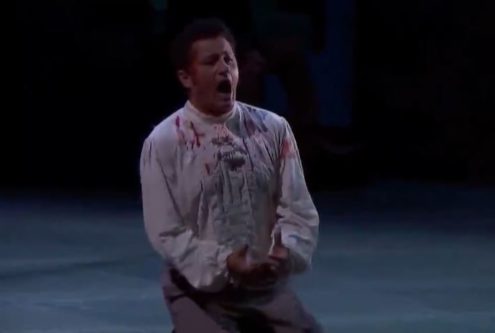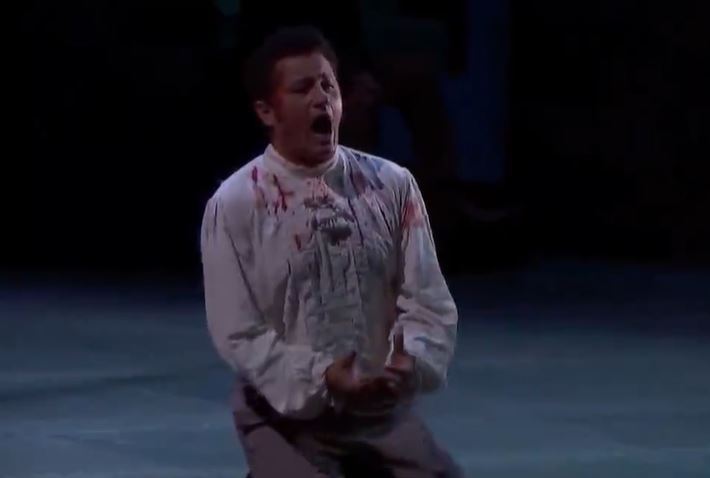 Austria Puccini, Tosca: Soloists, Chorus and Orchestra of the Vienna State Opera / Marco Armiliato (conductor). Directed for the screen by Ella Gallieni and recorded at the Vienna State Opera on 23.6.2019 and reviewed on 28.4.2020. (JPr)
Austria Puccini, Tosca: Soloists, Chorus and Orchestra of the Vienna State Opera / Marco Armiliato (conductor). Directed for the screen by Ella Gallieni and recorded at the Vienna State Opera on 23.6.2019 and reviewed on 28.4.2020. (JPr)

Production:
Director – Margarethe Wallmann
Revival director – Katharina Strommer
Sets and Costumes – Nicola Benois
Chorus master – Martin Schebesta
Cast:
Floria Tosca – Karine Babajanyan
Mario Cavaradossi – Piotr Beczala
Baron Scarpia – Carlos Álvarez
Cesare Angelotti – Sorin Coliban
Sacristan – Alexandru Moisiuc
Spoletta – Wolfram Igor Derntl
Sciaronne – Hans Peter Kammerer
Gaoler – Ayk Martirossian
Shepherd – Maryam Tahon
For some recent reviews from any opera available online, I have been concentrating on artists – such as, Roberto Alagna, Joseph Calleja and Anna Netrebko – who I was expecting to see soon had live performance throughout the world not become impossible because of the ongoing coronavirus pandemic. Another was to be Piotr Beczala who would soon have been Rodolfo in the Royal Opera’s La bohème. (He is also due to sing Radamès at the Met later this year, but this must be in considerable doubt in the prevailing circumstances in New York.) It was interesting to see – and surprisingly generally overlooked it appears – that he made a triumphant role debut as Cavaradossi in Vienna in February 2019 and sang it again there in June. In the belief that Beczala is the leading lyric tenor of his generation I was delighted to be able to see this recorded Tosca performance (23rd June) courtesy of Vienna State Opera’s vidéothèque.
There is a new regime in charge in Vienna and their new season (click here) suggests they will possibly revitalise the repertoire in future years but Margarethe Wallmann’s classic 1958 Tosca is definitely returning for more performances and so has entered deep into its seventh decade. This typifies the Vienna State Opera I have known and loved for over 40 years – ‘If it ain’t broke, don’t fix it’!’
Nicola Benois’s sets, costumes and Wallmann’s direction (such as it now is) are reminiscent of the famous 1976 filmed Tosca with Catherine Malfitano, Plácido Domingo, and Ruggero Raimondi which was performed in the actual Roman settings – the church of Sant’Andrea della Valle, Palazzo Farnese, Castel Sant’Angelo – described in the libretto and at the appropriate times of a June 1800 day. It is all as Puccini intended and why not? For Act I there was a realistic chapel to showcase the procession of the bishop, priests, altar boys, choristers, and worshippers for the well-populated ‘Te Deum’; Act II shows us Scarpia’s well-furnished chambers including a table, chaise longue, desk, and the requisite candelabra and concealed torture chamber; and for the final act we are on castle ramparts under a suitably starry sky.
To make this – or any? – Tosca work is three leading singing-actors who can create believable characters and involve the watching audience in the (very familiar?) story through the strength of their vocal and dramatic artistry. Much credit for the greatness of this performance goes to Karine Babajanyan who stepped in as Floria Tosca for an indisposed Nina Stemme at the very last moment it seems. Babajanyan was a credible diva who – as appropriate – was pious, jealous, passionate, despairing, defiant, or gullible. Her ‘Vissi d’arte’ was a prima donna’s cri du coeur from the depth of her soul and was deeply moving. I totally believed Babajanyan’s Tosca was genuinely capable of killing someone, and at the end of Act II Scarpia was vehemently despatched I suspect I am not the first to suggest how much the Armenian soprano resembled – and, at times, to her credit sounded like – Maria Callas!
Singing his role for the first time in Vienna, Carlos Álvarez looked exactly as you would expect Scarpia to look and he was a ruthless, sex-crazed brute with no hint of any redeeming feature. Accepting this – and because of his strong and vigorous singing – the ‘Te Deum’ has a visceral edge and his utterance of his threatening second act ‘Ebbene?’ (‘Well?’) was chilling.
Piotr Beczala stood out though – in what was a most effective Tosca trio – because of his increasingly versatile voice (he sings Puccini, Verdi and Wagner, equally well) that had no trouble – as heard through my laptop’s speakers – cutting effortlessly through the composer’s richly-layered orchestration. ‘Recondita armonia’ had been an exquisite scene-setter but was overshadowed by his final act ‘E lucevan le stelle’ that was as intense, impassioned, beautifully phrased, heartfelt, and moving, as I have ever heard it. The Viennese audience applauded long and loudly – as sometimes only they can! – and they were rewarded by Beczala singing it all over again and – if possible – even better second time. He was equally ardent during the duets and his stylish singing throughout proved how appropriate it was that Beczala was honoured with the prestigious title of Kammersänger onstage after this performance.
There were solid performances from everyone in the ensemble including Alexandru Moisiuc as a fairly serious Sacristan; Sorin Coliban’s forthright Angelotti; Wolfram Igor Derntl’s conspiratorial Spoletta; and Ayk Martirossian’s jobsworth Gaoler.
Puccini’s sumptuously dramatic score got full worth from the Vienna State Opera Orchestra conducted by the ever-reliable Marco Armiliato. From the musicians there was the typically wonderful sheen, resonance, and velvety sounds, they are renowned for. The balance of the recording also allowed for some details – often missed in the theatre – to be clearly heard; such as Tosca’s off-stage singing against the confrontation between Scarpia and Cavaradossi in Act II.
A very memorable evening and so – in the absence of having been there – it is good that it was documented for posterity by the Vienna State Opera.
Jim Pritchard
Vienna State Opera has opened its livestream archives of recordings of previous opera and ballet performances and these are available – some free – via its streaming platform.
